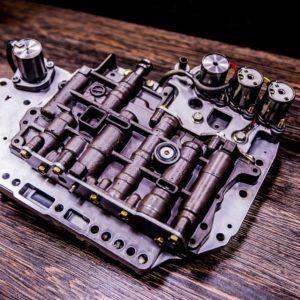Have you ever gotten a P2714 code while trying to diagnose what’s wrong with your vehicle? Don’t worry because we’re here to help you understand what this specific diagnostic trouble code (DTC) means so that you can identify its common causes and symptoms. If you’re looking to troubleshoot this code yourself, you’ll have to learn the basics.
What Does the P2714 Code Mean?
P2714 stands for “Pressure Control Solenoid D Performance or Stuck Off.” It’s a generic diagnostic code that usually applies to modern vehicles with automatic transmissions. A P2714 can affect vehicles from Toyota, Chevrolet, Lexus, Nissan, Acura, Mercedes-Benz, and many more.
A vehicle’s powertrain control module (PCM) can store a P2714 code if it detects a problem with the transmission pressure solenoid “D.” It’s possible that the pressure control “D” solenoid is malfunctioning or stuck in the “Off” position.

Transmission control solenoids are responsible for controlling the flow of hydraulic fluid throughout a vehicle’s automatic transmission system. The PCM receives electronic signals from a vehicle’s monitoring devices to direct the fluid from the pressure solenoids to hydraulic circuits that change the transmission gear ratio at the appropriate time. The pressure control solenoid maintains transmission system line pressure to promote smooth operation.

Note: The definition of code P2714 might be different depending on the vehicle manufacturer. Consult the appropriate repair manual or repair database to learn how to fix a P2714 code.
What are the Common Causes of the P2714 Code?
A P2714 code can be caused by a number of factors. Here are some of the most common causes of P2714 code.
- Faulty pressure control solenoid
- Contaminated or low fluid
- Dirty or clogged transmission filter
- Transmission pump issues
- Transmission valve body issues
- Internal transmission failure
- Damaged wiring or connectors
- Faulty PCM
What are the Common Symptoms of the P2714 Code?
A P2714 code might be accompanied by other DTCs, so you might notice some symptoms not listed here. However, if your PCM is only storing a P2714 code, your vehicle might exhibit the following symptoms.
- Illuminated check engine light
- The vehicle goes into limp mode
- Shifts in the transmission are too harsh or too soft
- Excessive transmission heat
- Transmission slips out of gear
- Reduced fuel efficiency
- Vehicle won’t move under its own power

How to Diagnose the P2714 Code
Apart from code P2714, the “D” pressure solenoid has several other trouble codes, including P2713, P2715, P2716, and P2717. Some symptoms might overlap with a P2714 code and complicate the diagnostic procedure. The following video might teach you how to diagnose this code on a basic level, but you still need to follow your vehicle’s recommended diagnostic and repair procedures to get an accurate idea of your vehicle’s underlying problems.
How to Fix the P2714 Code
There’s no cookie-cutter solution to troubleshooting DTCs like P2714. You’ll need sufficient knowledge and skills in auto repair to address a P2714 code and its problems. Fortunately, there are plenty of OBD-II resources available on the internet. You can find technical service bulletins from manufacturers and forum posts discussing certain problems. For beginners, we recommend looking for repair manuals and signing up for ALLDATA’s single-vehicle subscription service. These resources usually contain detailed information about parts.
Alternatively, you can hire a mechanic to look into the problem. They can run tests and perform the appropriate repairs to help you save time and effort on troubleshooting.
Any information provided on this Website is for informational purposes only and is not intended to replace consultation with a professional mechanic. The accuracy and timeliness of the information may change from the time of publication.















